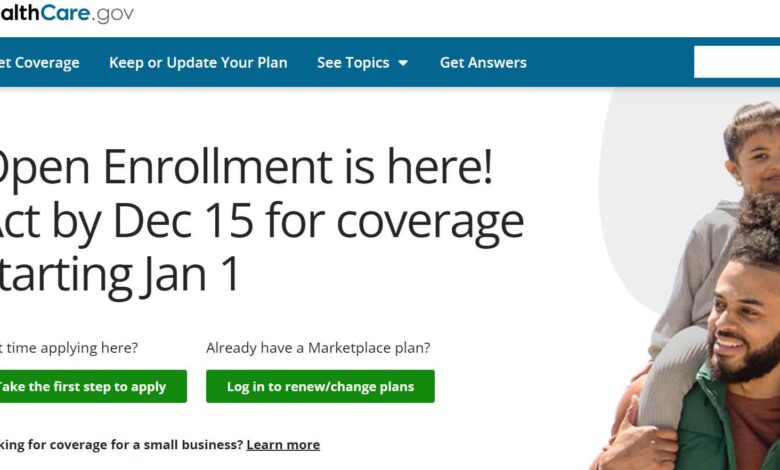CMS releases standards and payment parameters for plans on the ACA marketplace

The Centers for Medicare and Medicaid Services is proposing standards for issuers and marketplaces, as well as requirements for agents, brokers, web-brokers, direct enrollment entities and assisters operating on the Affordable Care Act marketplace in a Notice of Benefit and Payment Parameters for 2025 proposed rule,
User fee rates for 2025 would remain the same as those for the 2024 benefit year.
For the 2025 benefit year, CMS proposes a federally-facilitated marketplace user fee rate of 2.2% of total monthly premiums and a state-based marketplace-federal platform user fee rate of 1.8% of total monthly premiums.
For the 2025 benefit year, the Department of Health and Human Services would operate risk adjustment in every state and the District of Columbia.
CMS proposes a risk adjustment user fee for the 2025 benefit year of $0.20 per member, per month, which is a decrease from the 2024 benefit year risk adjustment user fee rate of $0.21 per member per month.
These costs cover development of the models and methodology, collections, payments, account management, data collection, data validation, program integrity and audit functions, operational and fraud analytics, interested parties training, operational support, and administrative and personnel costs dedicated to HHS-operated risk adjustment program activities.
For risk adjustment in 2025, CMS proposes to use the 2019, 2020 and 2021 enrollee-level Enhanced Data Rates for Global Evolution, or EDGE data for recalibration. Consistent with prior benefit year model recalibrations, this involves the use of the three most recent consecutive years of enrollee-level EDGE data to provide stability.
This minimizes volatility in changes to risk scores between benefit years due to differences in the dataset’s underlying populations, while reflecting the most recent years’ claims experience available, CMS said.
CMS also proposes to recalibrate the cost sharing reduction adjustment factors for American Indian and Alaska Native zero cost sharing and limited cost sharing plan variant enrollees for 2025. CMS will retain these proposed adjustment factors, if the rule is finalized, for future benefit years unless changed through notice-and-comment rulemaking.
CMS said it believes these proposed changes to adjustment factors align with efforts to make incremental changes to improve model prediction and predict plan liability more accurately for this population.
CMS also said it believes that these proposed changes would increase the incentives for issuers to engage the American Indian and Alaska Native population, whose communities have been historically underserved and face significant health disparities.
In addition, CMS proposes to retain the current cost sharing adjustment factors for silver plan variant enrollees for the 2025 benefit year and beyond unless changed through notice-and-comment rulemaking.
Along with the proposed rule, CMS is issuing the 2025 benefit year premium adjustment percentage index and related payment parameters in guidance before January 1, 2024, consistent with policy finalized in the 2022 Payment Notice.
WHY THIS MATTERS
The proposed rule includes several proposals impacting the Medicaid program, Children’s Health Insurance Program and the Basic Health Program.
These changes would further the goal of advancing health equity by addressing health disparities, CMS said.
They build on the Affordable Care Act’s promise to expand access to quality, affordable health coverage and care by increasing access to healthcare services, simplifying choice and improving the plan selection process, making it easier to enroll in coverage, enhancing standards and guaranteed consumer protections, reinterpreting the authority to access certain data through Medicaid, CHIP, and Marketplace Hub services, and strengthening markets.
To help ensure that Affordable Care Act marketplace enrollees across the nation have reasonable, timely access to healthcare providers as mandated by the ACA, CMS proposes that, for plan years beginning on or after January 1, 2025, state marketplaces and state-based marketplaces-federal platform establish and impose quantitative time and distance qualified health plan network adequacy standards that are at least as stringent as the federally-facilitated marketplace time and distance standards, excluding stand-alone dental plan issuers that qualify.
Consistent with the standards for the federally-facilitated marketplaces, the time and distance standards for state marketplaces and state-based marketplaces-federal platforms would be calculated at the county level and vary by county designation.
Similar to the federal process, issuers that are unable to meet the specified standards would be able to submit a justification to account for variances. In making a determination, considerations would include whether the exception is reasonable based on circumstances such as the local availability of providers and variables reflected in local patterns of care.
In addition, CMS proposes that state marketplaces and state-based marketplaces-federal platform collect information from issuers about whether their providers offer telehealth services to assist in informing network adequacy and provider access standards for future plan years.
At this time, CMS is not proposing that these marketplaces establish and impose appointment wait time standards or that they ensure the provider network of each qualified health plan meets applicable standards specified under the law.
OTHER BENEFIT STANDARDS
Dental benefit: CMS proposes to remove the regulatory prohibition on issuers from including routine non-pediatric dental services as a benefit, which would allow states to add routine adult dental services as an Essential Health Benefit in their EHB-benchmark plans.
This proposal would give states the opportunity to improve adult oral health and overall health outcomes, which could help reduce health disparities and advance health equity since these health outcomes are disproportionately low among marginalized communities, CMS said.
Under this proposal, states would be permitted to include routine non-pediatric dental services as a benefit.
Prescription drug benefit: CMS proposes to revise the minimum membership standards for pharmacy and therapeutics committees to include a consumer representative, as CMS believes that a variety of perspectives and expertise on these committees is crucial to ensure committee members review the evidence for formulary decisions unbiasedly.
Second, CMS proposes to codify its current policy that prescription drugs in excess of those covered by a state’s benchmark plan are considered essential health benefits and subject to those protections, including the annual limitation on cost sharing and the restriction on annual and lifetime dollar limits, unless the coverage of the drug is mandated by state action and is in addition to the essential health benefit.
Increased state flexibility: CMS proposes to provide states with greater flexibility to adopt income and/or resource disregards in determining financial eligibility for Medicaid for individuals excepted from application of the Modified Adjusted Gross Income financial methodologies.
Under this proposal, states would be allowed to target income and/or resource disregards for individuals in the same Medicaid eligibility group, provided the targeting criteria is reasonable, such as individuals in an area of a state with higher shelter costs.
This proposal would enable states to achieve targeted expansions of Medicaid coverage, in contrast to the all-or-nothing approach required by the current regulation, CMS said.
Simplifying choice: CMS proposes to follow the approach finalized in the 2024 Payment Notice concerning standardized plan option metal levels and to otherwise maintain continuity with the approach to standardized plan options finalized in the 2023 and 2024 Payment Notices.
CMS proposes to make only minor updates to the plan designs for 2025, such as modifying the maximum out-of-pocket and deductible values, to ensure these plans have actuarial values within the permissible range for each metal level.
CMS believes these standardized plan options continue to play a meaningful role in simplifying and streamlining the plan selection process by reducing the number of variables consumers must consider when selecting a plan option, making it easier for consumers to compare available plan options and reducing the risk of suboptimal plan selection.
CMS further believes these standardized plan options include several distinctive features, such as enhanced pre-deductible coverage for several benefit categories and copayments, instead of coinsurance rates for a greater number of benefit categories. This will continue to play an important role in reducing barriers to access, combatting discriminatory benefit designs and advancing health equity, CMS said.
In addition, CMS proposes an exceptions process to the limitation on the number of non-standardized plan options that issuers can offer to promote consumer access to plans with design features that facilitate the treatment of chronic and high-cost conditions, while continuing to reduce the risk of plan choice overload.
Under this proposal, issuers would be permitted to offer additional non-standardized plan options beyond the two-plan limit for 2025 and subsequent years if they demonstrate that these additional plans have reduced cost sharing of 25% or more for benefits pertaining to the treatment of chronic and high-cost conditions, relative to an issuer’s other non-standardized plan offerings in the same product network type, metal level and service area.
Issuers would not be limited in the number of exceptions permitted per product network type, metal level, inclusion of dental and/or vision benefit coverage and service area, so long as the required criteria are met.
Reduced cost sharing for these benefits advances health equity, since many of these chronic and high-cost conditions disproportionately impact disadvantaged populations, CMS said.
EHB Benchmark Update: For plan years beginning on or after January 1, 2027, CMS proposes three revisions to the standards for state selection of EHB-benchmark plans to address long-standing requests from states to improve, and reduce the burden of, the essential health benefit benchmark plan update process.
Second, CMS proposes to remove the generosity standard and to revise the typicality standard so that, in demonstrating that a state’s new EHB-benchmark plan provides a scope of benefits that is equal to the scope of benefits of a typical employer plan in the state.
Third, CMS proposes to remove the requirement for states to submit a formulary drug list as part of their documentation to change EHB-benchmark plans unless the state changes its prescription drug EHBs.
Re-Enrollment Hierarchy: CMS proposes to amend the marketplace re-enrollment hierarchy to require all marketplaces, state and federal to re-enroll enrollees with catastrophic coverage, including enrollees who will lose eligibility for catastrophic coverage, into a new qualified health plan for the coming plan year.
This policy would codify the current re-enrollment process for marketplaces on the federal platform. CMS proposes that all state and federal marketplaces implement this policy beginning with the open enrollment period for plan year 2025 coverage.
Special Enrollment Periods: CMS proposes to align the effective dates of coverage after a consumer selects a plan during a special enrollment period subject to regular coverage effective dates across all marketplaces beginning January 1, 2025, or an earlier date at the option of the marketplaces.
For ease of consumer experience and to prevent coverage gaps for consumers transitioning between different marketplaces or from other insurance coverage, CMS proposes that consumers who select and enroll in a plan during a special enrollment period with a regular coverage effective date receive coverage beginning the first day of the month after the consumer selects a plan.
CMS also proposes to amend the parameters around the availability of a special enrollment period that is granted to advance payment of the premium tax credit-eligible, qualified individuals with a projected household income at or below 150% of the federal poverty level.
CMS proposes to remove the limitation that this special enrollment period is only available when advance payment of the premium tax credit is available such that the applicable taxpayer’s tax percentage is set to zero. This special enrollment period would continue to be offered at the option of the marketplace.
Failure to File and Reconcile Process: CMS proposes to require state marketplaces to check failure-to-reconcile status at least annually and send consumer notices to tax filers found to have failed-to-reconcile, prior to determining a tax filer or their household ineligible for a tax credit.
This proposal would codify the procedures of marketplaces on the federal platform and impose the obligation on state marketplace so that tax filers enrolled in a state marketplace would have more adequate notice to correct potential failed tax reconciliation. Nothing in this proposal relieves the consumer of their requirement to file and reconcile taxes after the receipt of advance payment of the premium tax credit.
Improving Incarceration Status: CMS proposes that all marketplaces accept consumer attestation of incarceration status without further verification.
CMS found that connecting to an alternative incarceration data source would be costly, and the rate of incarcerated individuals applying for coverage is very low. Continuing to use electronic data sources to verify incarceration status would add to current costs and health equity challenges because incarceration Data Matching Issues, which are costly and burdensome to applicants, would continue to be generated.
CMS proposes that state marketplaces that wish to verify incarceration status using an alternative electronic data source should submit their proposed alternative data source for HHS approval.
Effective Date of Coverage: CMS proposes to provide states that operate the Basic Health Program additional flexibility in establishing an effective date of eligibility for enrollment in a standard health plan. The proposal would allow a state to select a standard in which all applicants who meet all requirements are eligible to enroll in a standard health plan effective the first day of the month following the month of application or eligibility determination regardless of when they apply or are found eligible to enroll.
State-Mandated Benefits: CMS proposes that state-mandated benefits would not be considered “in addition to EHB” under CMS’ defrayal policy if the mandated benefit is an EHB in the state’s EHB-benchmark plan.
State Marketplace Transition: CMS proposes to require a state to operate for at least one year, including its open enrollment period, a state-based marketplace on the federal platform prior to transitioning to operating a state marketplace.
Centralized Eligibility and Enrollment Platform: CMS proposes to require a state marketplace to operate a centralized eligibility and enrollment platform on its website, allowing for the submission of the single, streamlined application for enrollment and insurance affordability programs.
Marketplace Call Center Standards: CMS proposes establishing call center standards to require that all marketplace call centers provide consumer access to a live call center representative during published hours of operation.
Marketplace call centers for SBM-FPs and Small Business Health Options Program (SHOP) Marketplaces that do not provide for enrollment in SHOP coverage through an online SHOP enrollment platform would be exempt.
CMS proposes that the marketplace’s live call center representatives would be required to be able to assist consumers with their application, which includes providing consumers information on their advanced tax credits and cost-sharing reduction eligibility, helping consumers understand their plan options, helping consumers select a plan and helping consumers submit enrollment applications to the marketplace.
Open Enrollment Dates: CMS proposes to require state marketplaces not using the federal platform to provide an annual open enrollment period that starts on November 1 and ends no earlier than January 15.
This would ensure a minimum open enrollment period consistent across all marketplaces while maintaining the flexibility for state marketplaces to hold a lengthier open enrollment period.
HHS Standards: CMS proposes to extend certain existing HHS standards for marketplaces that use the federal platform that apply to web-brokers and direct enrollment entities assisting consumers on those marketplaces to newly apply to web-brokers and direct enrollment entities assisting consumers on individual marketplaces and SHOPs in state marketplaces.
CMS proposes that minimum federal standards governing web-broker website display of standardized comparative plan information, display of information pertaining to a consumer’s eligibility for a tax credit or CSRs, disclaimer language, providing consumers with correct information, and refraining from certain conduct, access by downstream agents and brokers, and operational readiness would apply to web-brokers across all marketplaces.
CMS also proposes minimum federal standards governing direct enrollment entity marketing and displaying QHPs and non-QHPs, website disclaimer language, application assisters, providing consumers with correct information and refraining from certain conduct, and operational readiness would apply across all marketplaces.
Under these proposals, state marketplaces that do not use the federal platform would retain some flexibility to customize certain processes to best meet their needs consistent with these minimum requirements.
HealthCare.gov Changes: CMS proposes that HealthCare.gov changes be reflected and prominently displayed on direct enrollment entity non-marketplace websites in federal and state-federal platform states within a specific notice period set by HHS.
Section 1332 Waivers: HHS and the Department of the Treasury propose to modify regulations to set forth flexibilities in the public notice requirements and post-award public participation requirements for Section 1332 waivers.
Specifically, the departments propose to permit states applying for Section 1332 waivers to conduct public hearings in a virtual platforms or hybrid format in lieu of conducting an in-person meeting as part of state public notice requirements.
Authority to Access Data: State marketplaces and state Medicaid and CHIP agencies pay to access income data via the Verify Current Income Hub Service. CMS is proposing to reinterpret agency use of the Federal Data Services Hub to access and use the income data. HHS would continue to maintain contracts that make this service available through the Hub for State Marketplace.
Under this proposal, states would pay annually in advance for the anticipated utilization of the optional VCI Hub service. However, State Medicaid and CHIP agencies could request federal financial participation for their share of the costs. In addition, states may receive a 75% federal match for their Medicaid system operational costs to obtain CSI income data via the VCI Hub service.
For more on the benefit and payment parameters, please see the Notice of Benefit and Payment Parameters for 2025 proposed rule.
Twitter: @SusanJMorse
Email the writer: SMorse@himss.org
Source link



